Impact of Boundary Conditions on the Performance Enhancement of Advanced Control Strategies for a Residential Building with a Heat Pump and PV System with Energy Storage
Abstract
1. Introduction
1.1. Previous Work
1.2. Aim, Scope and Novelty of the Study
2. Methodology
2.1. Reference Building Model
2.2. Compact Heat Pump System
2.3. PV System
2.4. Battery Storage
2.5. Operational Control Strategies
2.6. Energetic and Economic Performance Indicators
3. Examined Boundary Conditions
3.1. Country
3.2. Meteorological Data
3.3. Building Insulation Standards
3.4. Electricity, Occupancy, Room Set Temperature, and DHW Profiles
3.5. Dynamic Electricity Tariffs
4. Results and Discussion
4.1. Energy Use Analysis
4.2. Economic Analysis
4.3. Thermal Comfort
4.4. Discussion
5. Conclusions
Author Contributions
Funding
Conflicts of Interest
References
- EU Directive 2018/2001 on the Promotion of the Use of Energy from Renewable Sources. Available online: https://eur-lex.europa.eu/legal-content/EN/TXT/HTML/?uri=CELEX:32018L2001&from=EN (accessed on 2 May 2019).
- Eurostat. Energy Consumption in Households EU-28. 2016. Available online: https://ec.europa.eu/eurostat/statisticsexplained/index.php?title=Energy_consumption_in_households#Energy_consumption_in_households_by_type_of_end-use (accessed on 2 May 2019).
- EHPA. Available online: https://www.google.com/search?client=firefox-ab&q=Axell+M%2C+Karlsson+F.+IEA+Heat+Pump+Centre%2C+Europe%3A+Heat+pumps%E2%80%94Status+and+trends (accessed on 30 April 2019).
- Psimopoulos, E.; Bee, E.; Widen, J.; Bales, C. Techno-economic analysis of control algorithms for an exhaust air heat pump system for detached houses coupled to a photovoltaic system. Appl. Energy 2019, 249, 355–367. [Google Scholar] [CrossRef]
- Arteconi, A.; Hewitt, N.J.; Polonara, F. Domestic demand-side management (DSM): Role of heat pumps and thermal energy storage (TES) systems. Appl. Therm. Eng. 2013, 51, 155–165. [Google Scholar] [CrossRef]
- Thür, A.; Calabrese, T.; Streicher, W. Smart grid and PV driven ground heat pump as thermal battery in small buildings for optimized electricity consumption. Sol. Energy 2018, 174, 273–285. [Google Scholar] [CrossRef]
- Dar, U.I.; Sartori, I.; Georges, L.; Novakovic, V. Advanced control of heat pumps for improved flexibility of Net-ZEB towards the grid. Energy Build. 2014, 69, 74–84. [Google Scholar] [CrossRef]
- Schibuola, L.; Scarpa, M.; Tambani, C. Demand response management by means of heat pumps controlled via real time pricing. Energy Build. 2015, 90, 15–28. [Google Scholar] [CrossRef]
- Alimohammadisagvand, B.; Jokisalo, J.; Sirén, K. Comparison of four rule-based demand response control algorithms in an electrically and heat pump-heated residential building. Appl. Energy 2017, 209, 167–179. [Google Scholar] [CrossRef]
- Fischer, D.; Bernhardt, J.; Madani, H.; Wittwer, C. Comparison of control approaches for variable speed air source heat pumps considering time variable electricity prices and PV. Appl. Energy 2017, 204, 93–105. [Google Scholar] [CrossRef]
- Beck, T.; Kondziella, H.; Huard, G.; Bruckner, T. Optimal operation, configuration and sizing of generation and storage technologies for residential heat pump systems in the spotlight of self-consumption of photovoltaic electricity. Appl. Energy 2016, 188, 604–619. [Google Scholar] [CrossRef]
- Rodríguez, L.R.; Ramos, J.S.; Domínguez, S.Á.; Eicker, U. Contributions of heat pumps to demand response: A case study of a plus-energy dwelling. Appl. Energy 2018, 214, 191–204. [Google Scholar] [CrossRef]
- Salpakari, J.; Lund, P. Optimal and rule-based control strategies for energy flexibility in buildings with PV. Appl. Energy 2015, 161, 425–436. [Google Scholar] [CrossRef]
- Schopfer, S.; Tiefenbeck, V.; Staake, T. Economic assessment of photovoltaic battery systems based on household load profiles. Appl. Energy 2018, 223, 229–248. [Google Scholar] [CrossRef]
- Quoilin, S.; Kavvadias, K.; Mercier, A.; Pappone, I.; Zucker, A. Quantifying self-consumption linked to solar home battery systems: Statistical analysis and economic assessment. Appl. Energy 2016, 182, 58–67. [Google Scholar] [CrossRef]
- Fedrizzi, R.; Dipasquale, C.; Bellini, A.; Gustafsson, M.; Bales, C.; Ochs, F.; Dermentzis, G.; Nouvel, R.; Cotrado, M. D6.3b Performance of the Studied Systemic Renovation Packages-Single Family Houses. Available online: http://urn.kb.se/resolve?urn=urn:nbn:se:du-29988 (accessed on 15 March 2020).
- Bee, E.; Prada, A.; Baggio, P.; Psimopoulos, E. Air-source heat pump and photovoltaic systems for residential heating and cooling: Potential of self-consumption in different European climates. Build. Simul. 2019, 12, 453. [Google Scholar] [CrossRef]
- Felten, B.; Weber, C. The value(s) of flexible heat pumps—Assessment of technical and economic conditions. Appl. Energy 2018, 228, 1292–1319. [Google Scholar] [CrossRef]
- Nord Pool, Market Data. Available online: https://www.nordpoolgroup.com/Market-data1/#/nordic/table (accessed on 3 April 2019).
- Epex Spot, Market Data. Available online: https://www.epexspot.com (accessed on 3 April 2019).
- IRENA (2019). Future of Solar Photovoltaic: Deployment, Investment, Technology, Grid Integration and Socio-Economic Aspects (A Global Energy Transformation: Paper), International Renewable Energy Agency, Abu Dhabi. Available online: https://www.irena.org/-/media/Files/IRENA/Agency/Publication/2019/Nov/IRENA_Future_of_Solar_PV_2019.pdf (accessed on 12 December 2019).
- Klein, S.A.; Beckman, W.A.; Mitchell, J.W.; Duffie, J.A.; Duffie, N.A.; Freeman, T.L.; Mitchell, J.C.; Braun, J.E.; Evans, B.L.; Kummer, J.P.; et al. Trnsys Users Manual, Version 17; University of Wisconsin Solar Energy Laboratory: Madison, WI, USA, 2010; Volume 4. [Google Scholar]
- Widén, J.; Lundh, M.; Vassileva, I.; Dahlquis, E.; Ellegård, K.; Wäckelgård, E. Constructing load profiles for household electricity and hot water from time-use data—Modelling approach and validation. Energy Build. 2009, 41, 753–768. [Google Scholar] [CrossRef]
- Wyrsch, N.; Riesen, Y.; Balif, C. Effect of the fluctuations of PV production and electricity demand on the PV electricity self-consumption. In Proceedings of the 28th EU PVSEC, Paris, France, 30 September–4 October 2013. [Google Scholar]
- Persson, T.; Heier, J. Småhusens framtida utformning: Hur påverkar Boverkets nya byggregler? [How Do the New Swedish Building Codes Affect Detached Houses of the Future?]; Region Gävleborg: Gävle, Sweden, 2010. [Google Scholar]
- Leppin, L. Development of Operational Strategies for a Heating Pump System with Photovoltaic, Electrical and Thermal Storage. Bachelor’s Thesis, Dalarna University, Borlänge, Sweden, 2017. urn:nbn:se:du-27304. [Google Scholar]
- Bales, C.; Betak, J.; Broum, M.; Chèze, D.; Cuvillier, G.; Haberl, R.; Hafner, B.; Haller, M.; Hamp, Q.; Heinz, A.; et al. Optimized Solar and Heat Pump Systems, Components and Dimensioning: MacSheep—New Materials and Control for a Next Generation of Compact Combined Solar and Heat Pump Systems with Boosted Energetic and Exergetic Performance. Available online: http://www.macsheep.spf.ch/ (accessed on 20 April 2019).
- Bletterie, B.; Bründlinger, R.; Lauss, G. On the characterisation of PV inverters’ efficiency—Introduction to the concept of achievable efficiency. Prog. Photovolt. 2011, 19, 423–435. [Google Scholar] [CrossRef]
- Luthander, R.; Widén, J.; Nilsson, D.; Palm, J. Photovoltaic self-consumption in buildings: A review. Appl. Energy 2015, 142, 80–94. [Google Scholar] [CrossRef]
- Kuhn, T.; Fath, K.; Bales, C.; Gustafsson, M.; Nouvel, R.; Fedrizzi, R. “D2.3 RES Availability Survey and Boundary Conditions for Simulations”. 2014. Available online: https://www.semanticscholar.org/paper/D2.3-RES-availability-survey-and-boundary-for-Kuhn-Fath/48799f59b1d94a93b9df6d4f16dcf0b6450e3d63. (accessed on 12 December 2019).
- Copernicus Atmosphere Monitoring Service (CAMS). Available online: https://atmosphere.copernicus.eu/ (accessed on 20 April 2019).
- Modern-Era Retrospective Analysis for Research and Applications, (MERRA-2) Service. Available online: https://gmao.gsfc.nasa.gov/reanalysis/MERRA-2/ (accessed on 20 April 2019).
- TABULA Webtool. National Building Codes. Available online: http://episcope.eu/building-typology/country/ (accessed on 20 December 2019).
- Concerted Action, Energy Performance of Buildings Directive. Available online: https://epbd-ca.eu/ca-outcomes. (accessed on 24 February 2020).
- Spain, National Regulations (CTE-HE). 2006. Available online: https://www.codigotecnico.org/index.php/menu-ahorro-energia.html (accessed on 25 February 2020).
- Widén, J.; Wäckelgård, E. A high-resolution stochastic model of domestic activity patterns and electricity demand. Appl. Energy 2010, 87, 1880–1892. [Google Scholar] [CrossRef]
- International Organization for Standardization. (2005) Ergonomics of the Thermal Environment—Analytical Determination and Interpretation of Thermal Comfort Using Calculation of the PMV and PPD Indices and Local Thermal Comfort Criteria (ISO Standard no.7730:2005). Available online: https://www.iso.org/obp/ui/#iso:std:iso:7730:ed-3:v1:en, (accessed on 11 August 2018).
- Electricity Prices Components for Household Consumers-Annual Data (from 2007 Onwards) Eurostat. Available online: http://appsso.eurostat.ec.europa.eu/nui/submitViewTableAction.do (accessed on 3 October 2019).
- López Prol, J.; Steininger, K.W. Photovoltaic self-consumption regulation in Spain: Profitability analysis and alternative regulation schemes. Energy Policy 2017, 108, 742–754. [Google Scholar] [CrossRef]
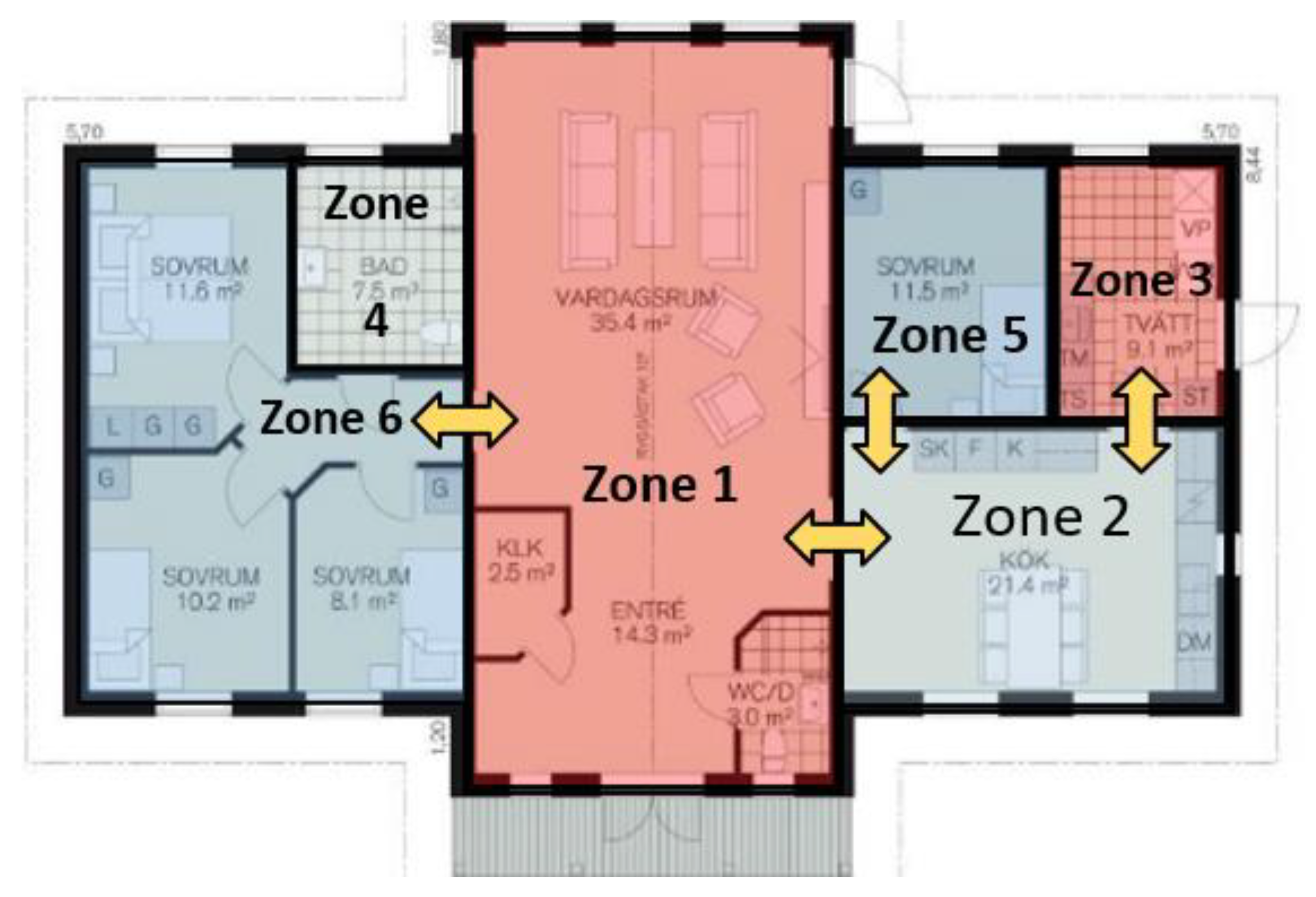
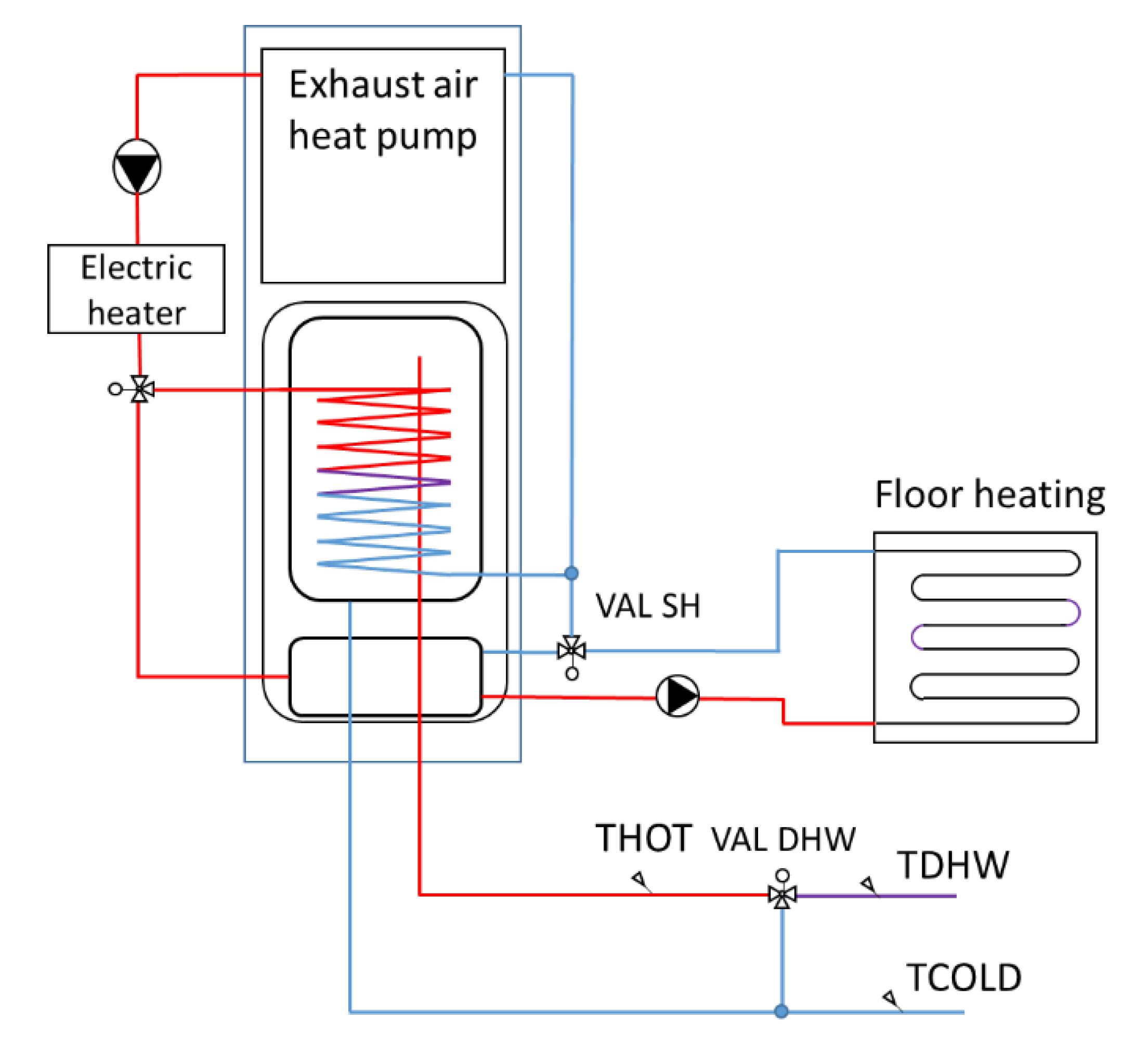
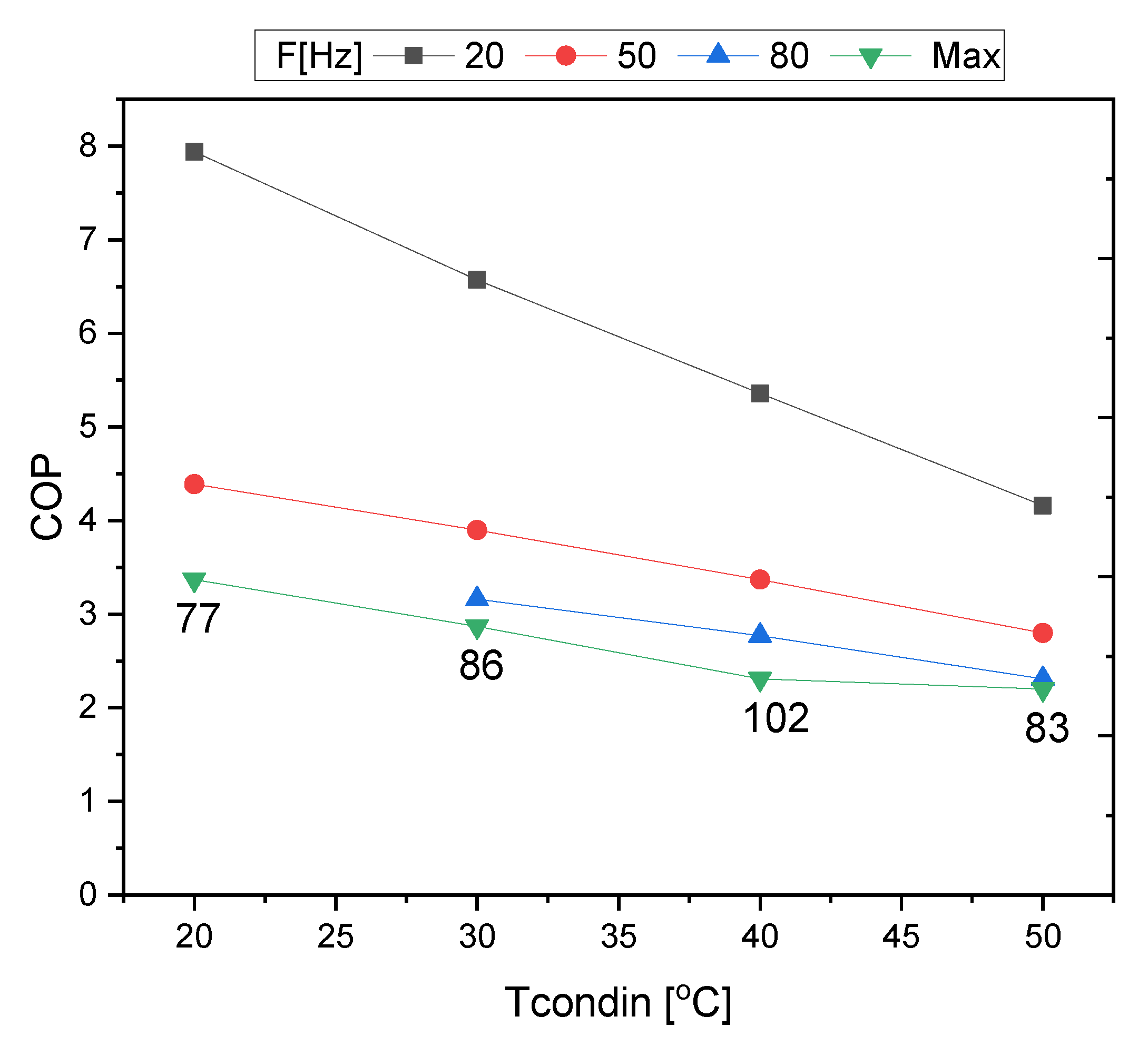
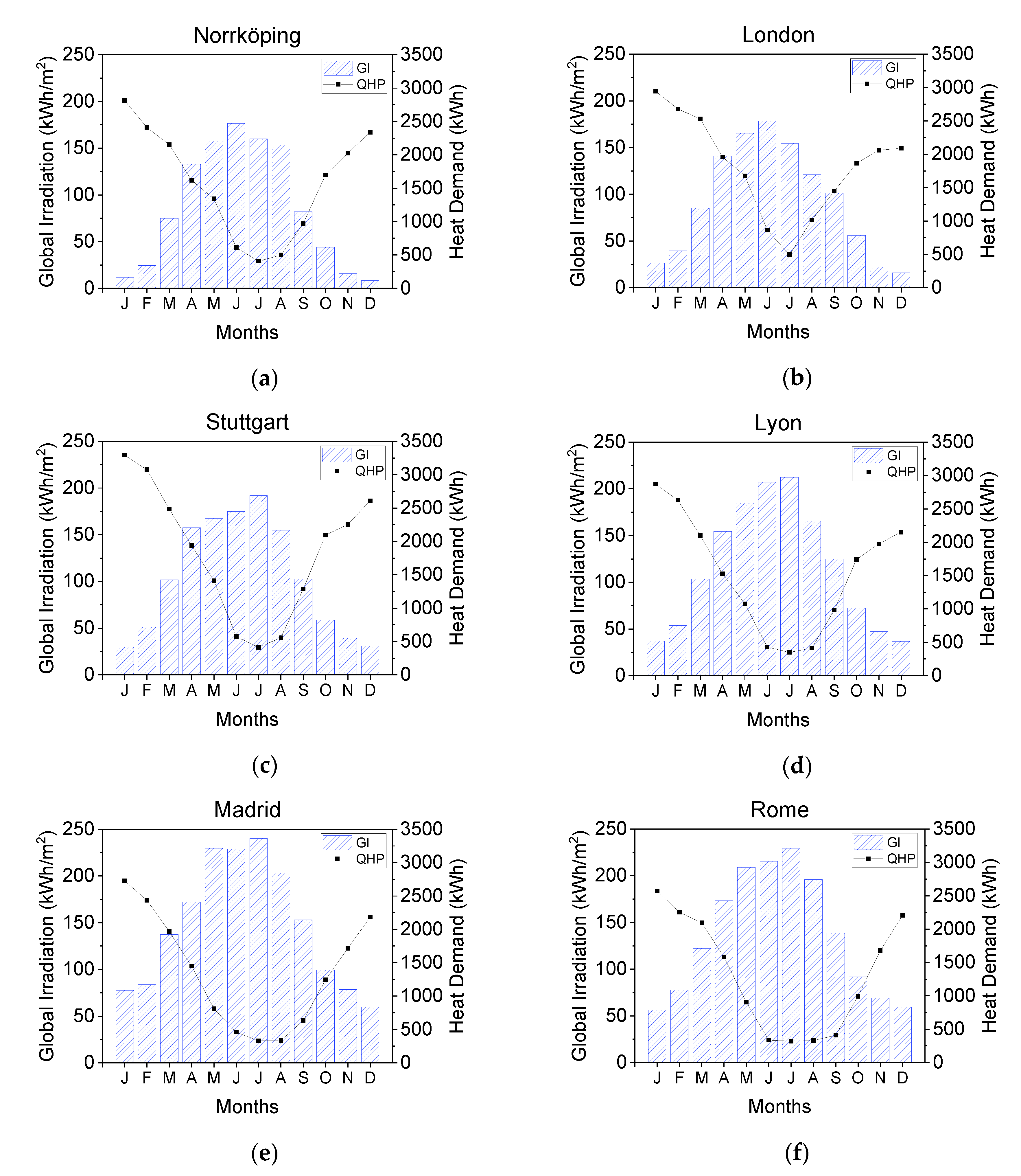
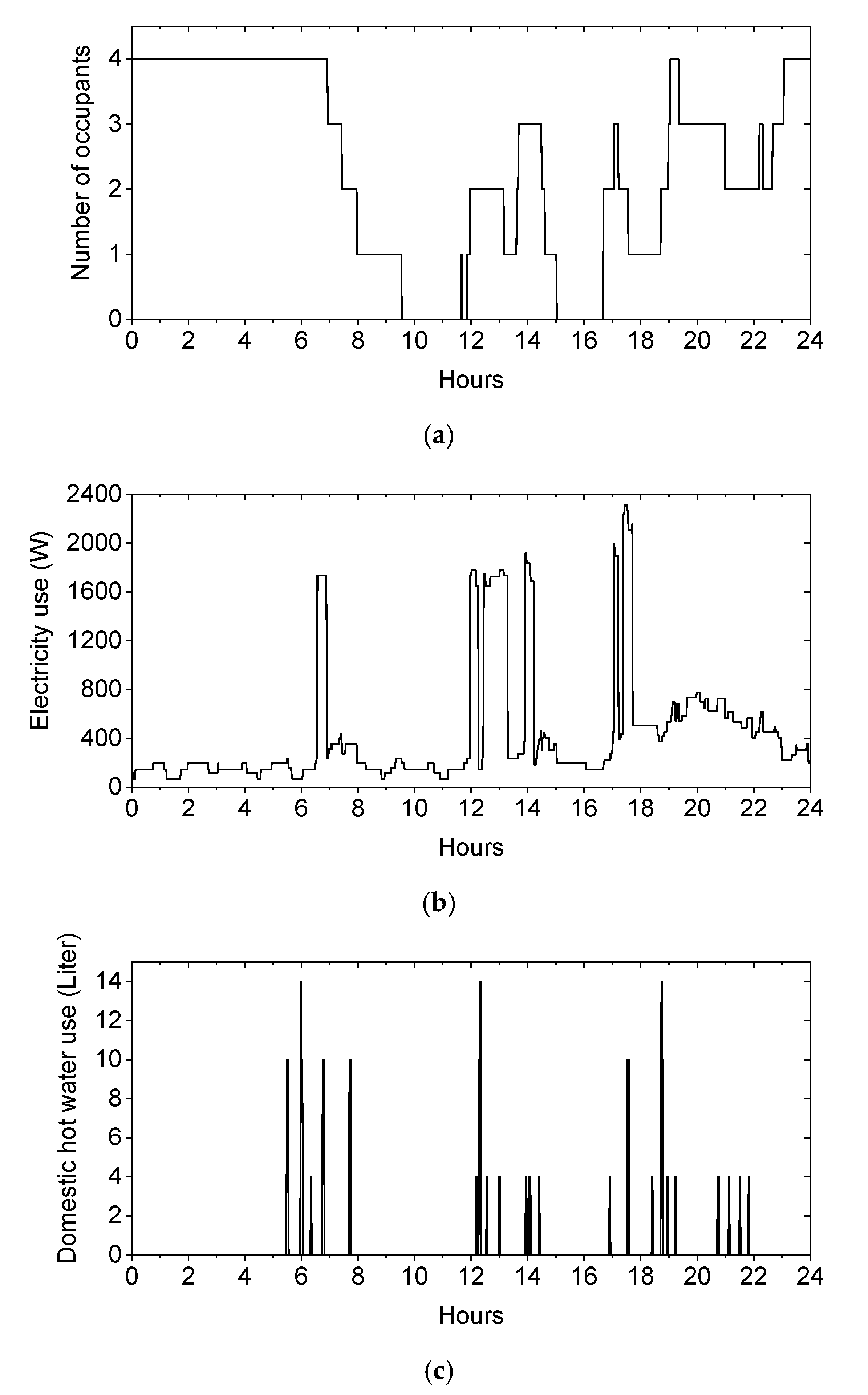

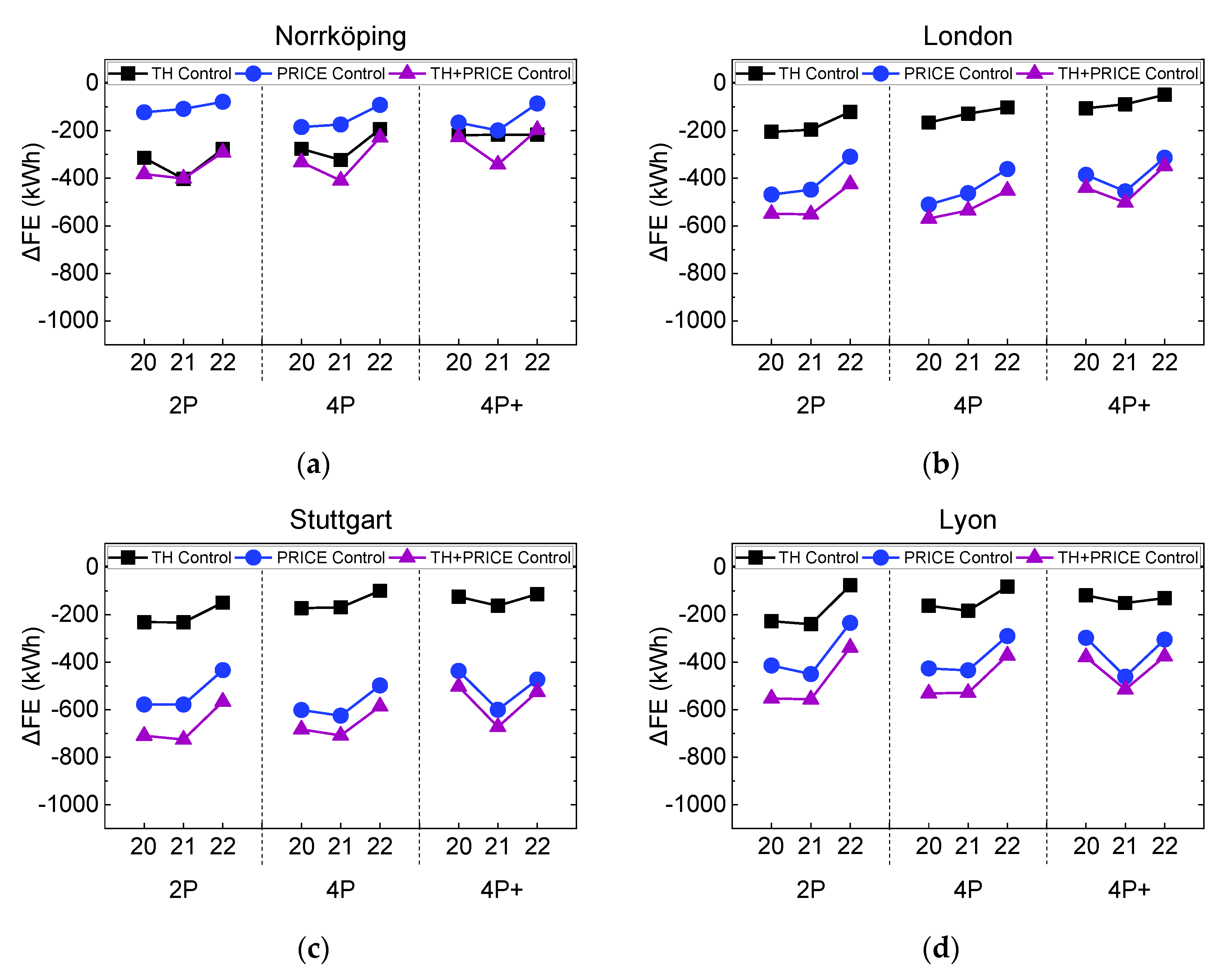
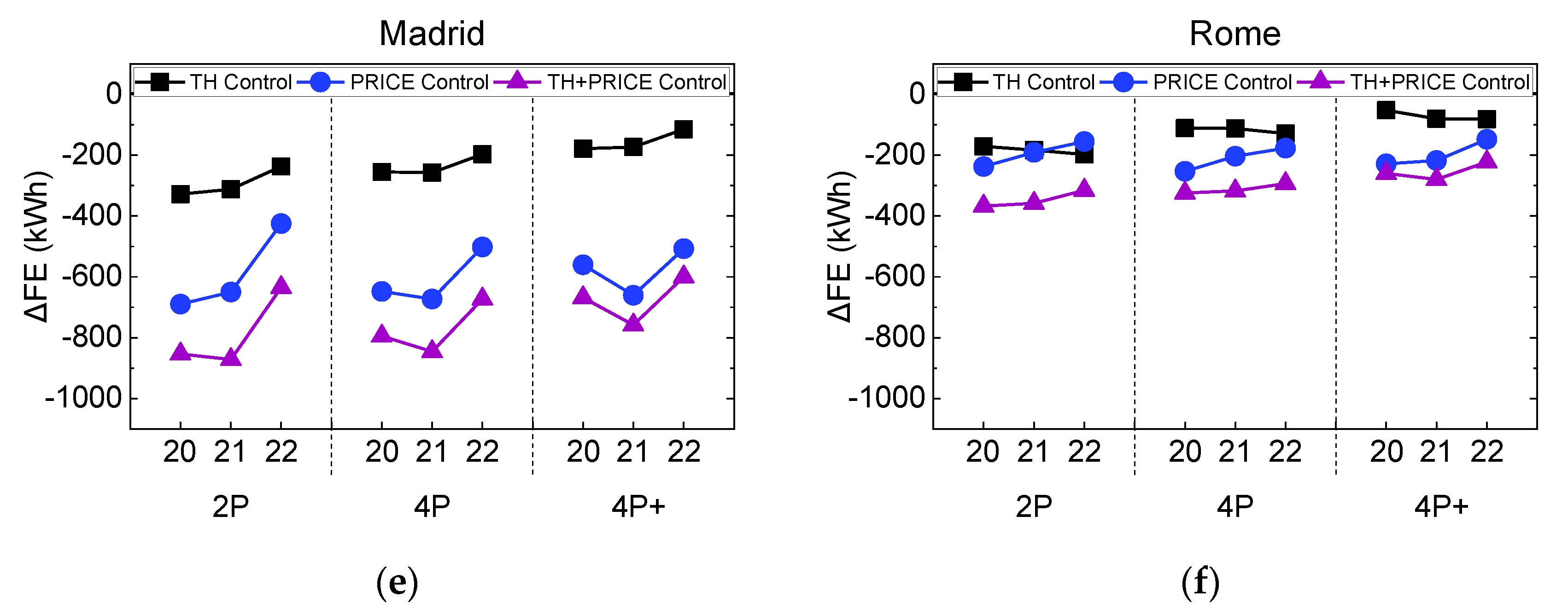
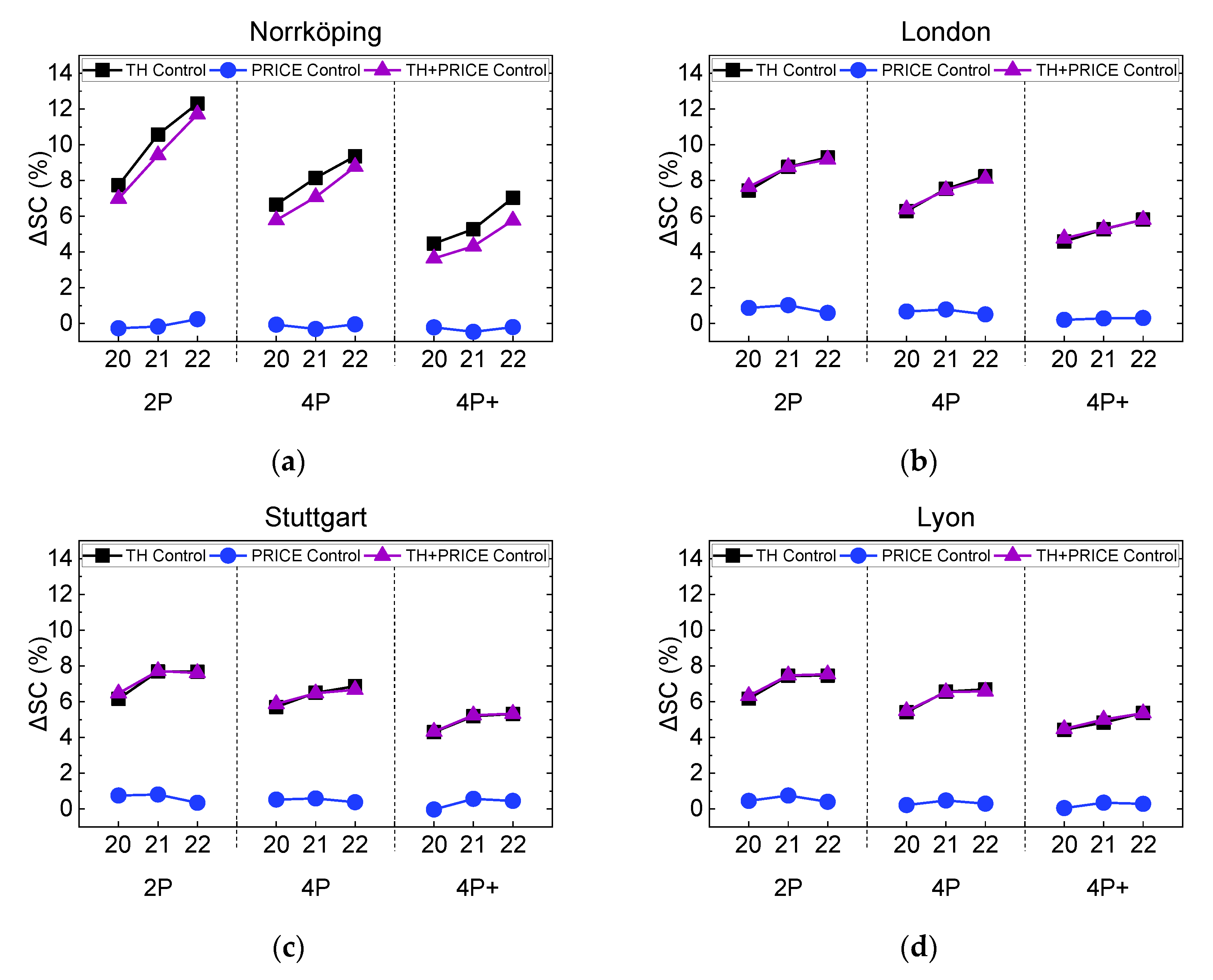
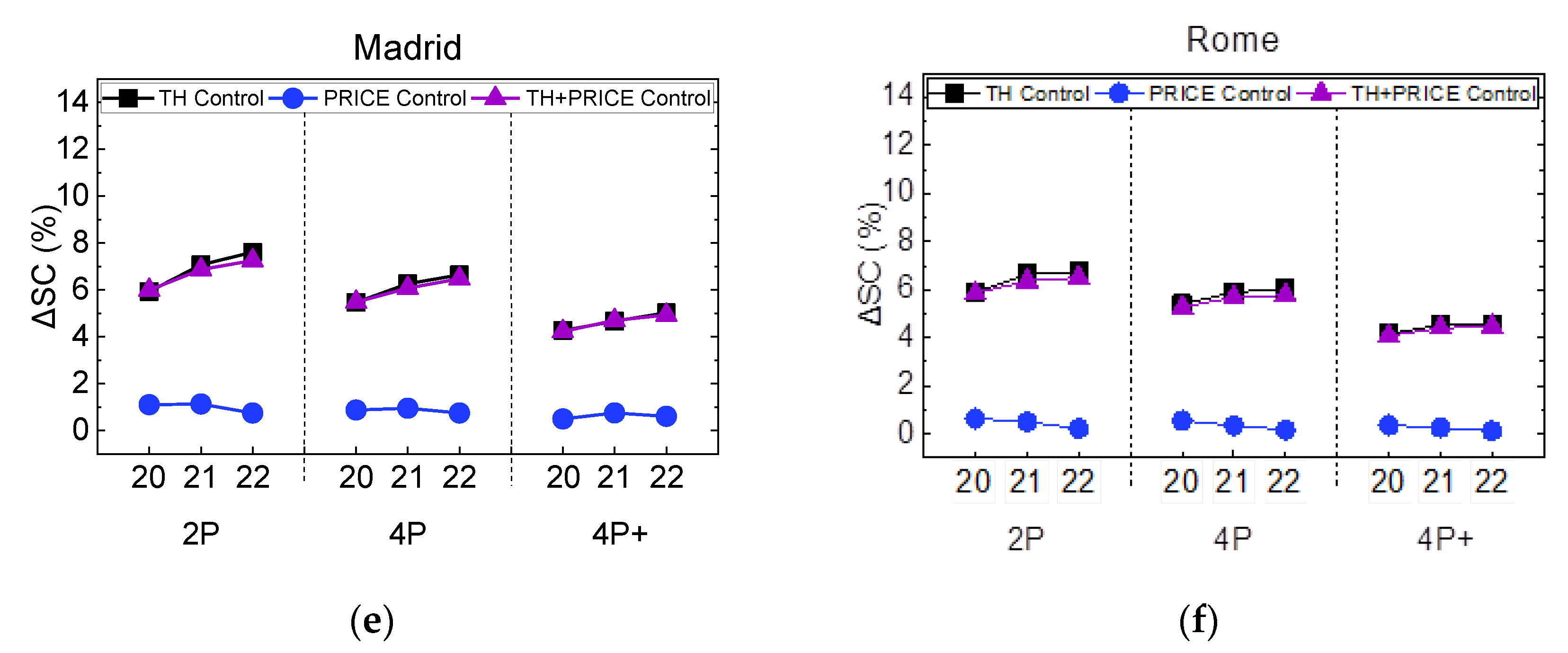
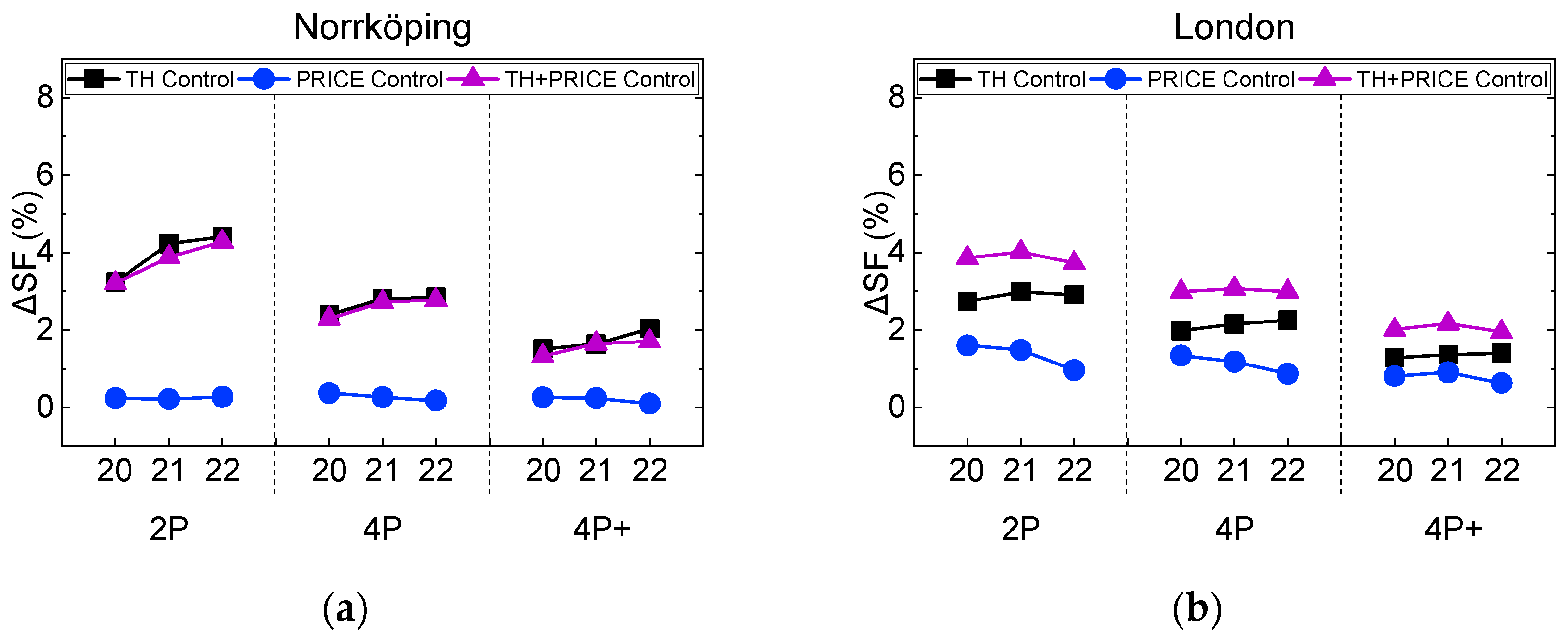
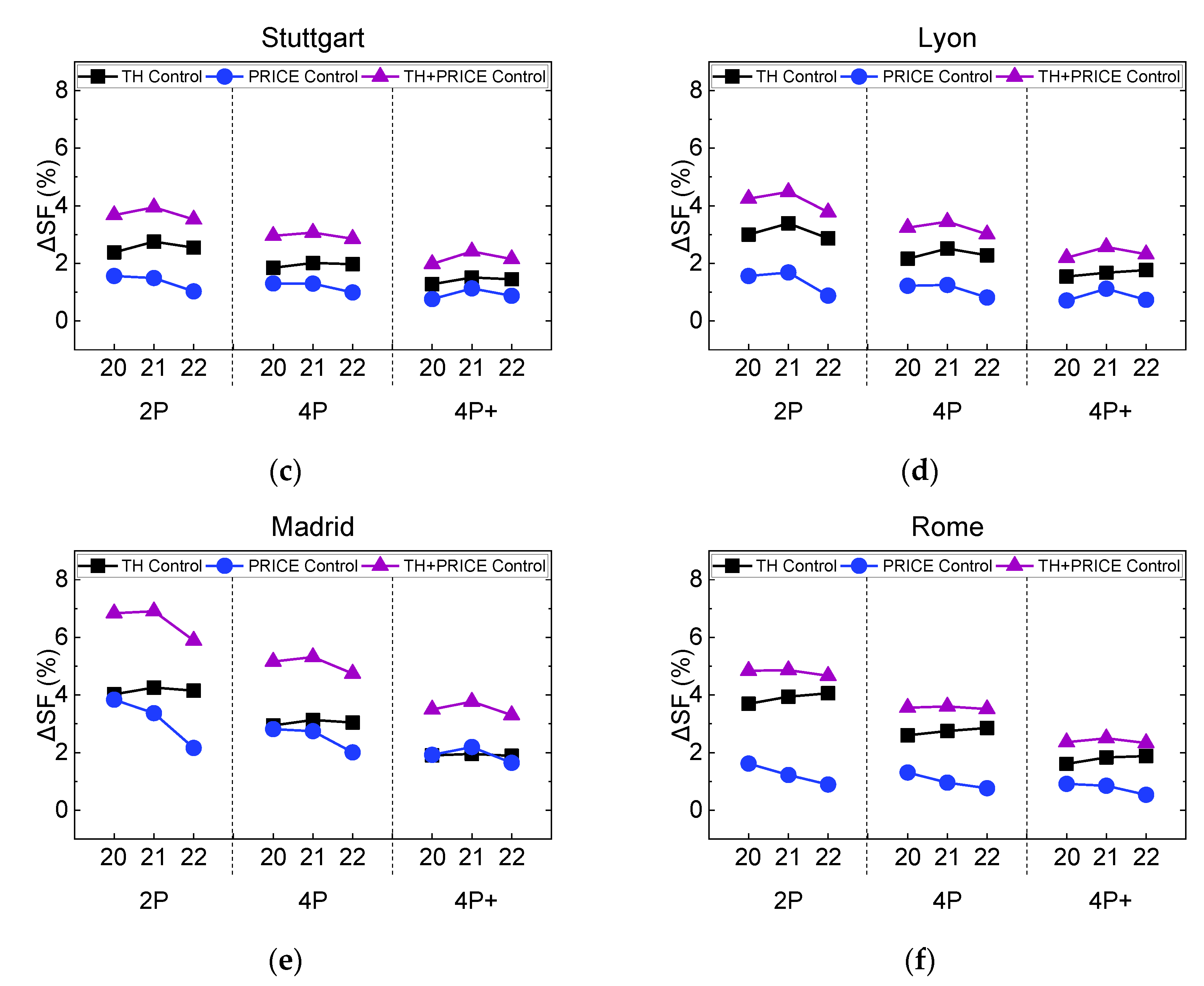
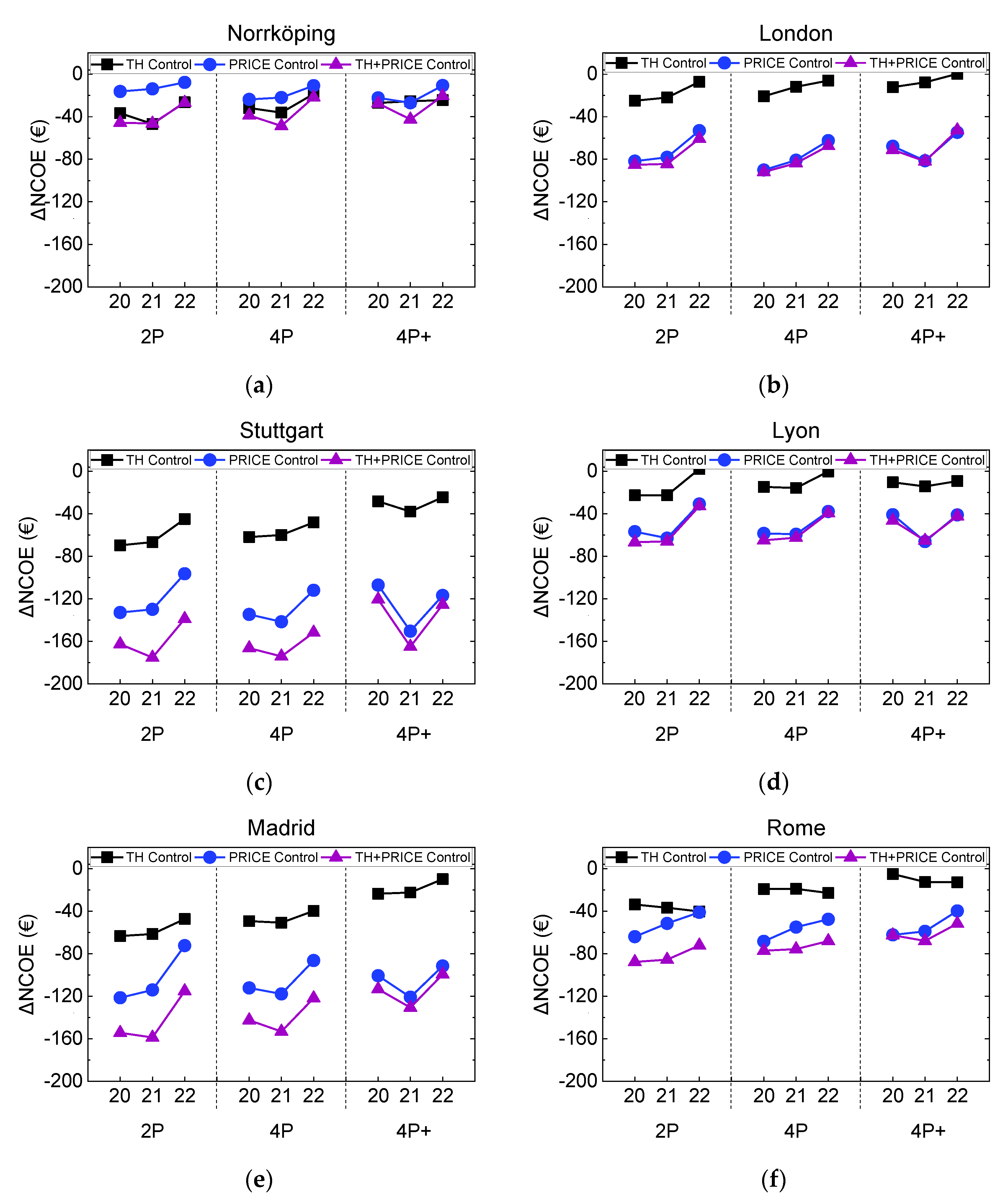
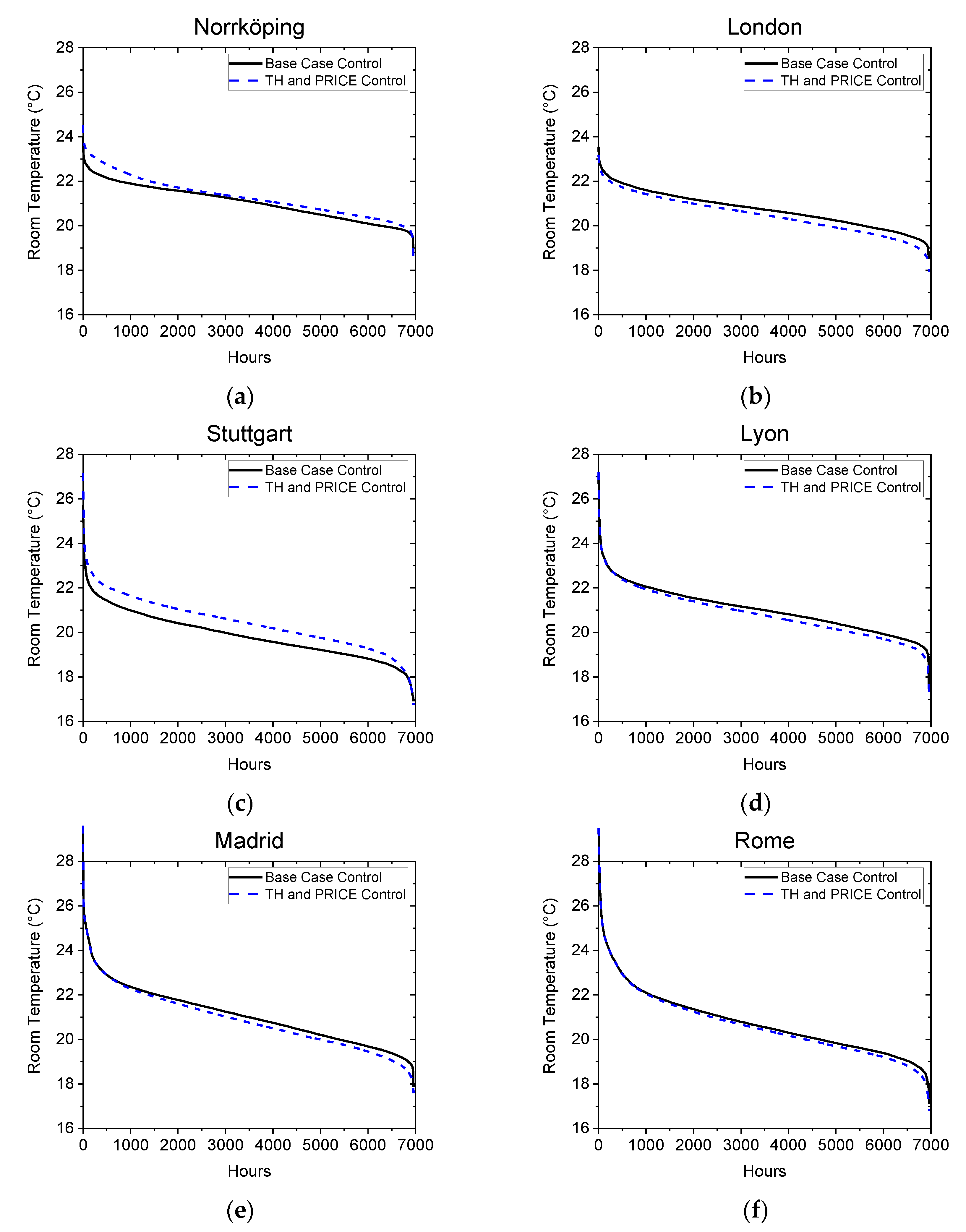
| Preference | Quantity |
|---|---|
| Electric compressor power (kW) | 0.25–1.88 |
| Thermal power of HP (kW) | 1.34–4.35 |
| Heat pump COP | 2.3–5.4 |
| DHW storage tank capacity (liter) | 180 |
| Electric auxiliary heater (kW) | 0.5–6.5 |
| Preference | Quantity |
|---|---|
| Capacity PV (kW) | 3.12, 5.7 |
| Inverter efficiency (%) | 97.7 |
| PV tilt (°) | 27 |
| PV azimuth (°) | 0 |
| Capacity battery (kWh) | 3.6, 7.2 |
| Round-trip battery efficiency (%) | 90 |
| Limits of state of charge (%) | 10–90 |
| Simulation Cases | Price Signal | PV Excess | SH Setpoint | DHW Setpoint | Priority |
|---|---|---|---|---|---|
| Base case | 0 | To grid | Ref | Ref | None |
| Base case + EL | 0 | Charging, PVexcess > 0 | Ref | Ref | Appliances |
| Charging | |||||
| TH + EL | 0 | Overheating SH, DHW PVexcess > 320 | +1 K 1 | +6 K 1 | Appliances |
| Thermal | |||||
| PRICE + EL | 1 | Charging, PVexcess > 0 | ±0.5 K 2 | Ref | Appliances |
| PRICE_TH + EL | 1 | Overheating SH, DHW PVexcess > 320 | ±0.5 K 2, 1 K 1 | Ref, +6 K 1 | Appliances |
| Thermal | |||||
| Charging |
| Locations | Climate Zones | Heating Degree Days |
|---|---|---|
| Norrköping (Sweden) | Nordic | 2000 |
| London (UK) | Oceanic | 1037 |
| Stuttgart (Germany) | Continental | 1548 |
| Lyon (France) | South Continental | 986 |
| Madrid (Spain) | Southern Dry | 775 |
| Rome (Italy) | Mediterranean | 403 |
| Wall | Window | Floor | Roof | Overall | |
|---|---|---|---|---|---|
| Sweden | 0.23 | 1.27 | 0.12 | 0.09 | 0.20 |
| UK | 0.35 | 1.8 | 0.35 | 0.2 | 0.37 |
| Germany | 0.3 | 1.4 | 0.28 | 0.25 | 0.33 |
| France | 0.27 | 1.4 | 0.17 | 0.22 | 0.28 |
| Spain | 0.3 | 1.4 | 0.28 | 0.25 | 0.33 |
| Italy | 0.34 | 2.2 | 0.33 | 0.28 | 0.42 |
| Occupancy | Annual Electricity Consumption Appliances (kWh/year) | Annual Electricity Consumption HP (kWh/year) | Annual DHW Consumption (kWh/year) |
|---|---|---|---|
| 2P | 2689 | 6360 | 2469 |
| 4P | 3649 | 6964 | 4159 |
| 4P+ | 5506 | 6420 | 4159 |
| Sweden | UK | Germany | France | Spain | Italy | |
|---|---|---|---|---|---|---|
| Energy and supply (Euro-ct/kWh) | 3.9 | 12.1 | 7.0 | 5.7 | 12.0 | 9.6 |
| Network (Euro-ct/kWh) | 5.5 | 4.6 | 6.0 | 4.3 | 4.5 | 8.5 |
| Energy taxes (Euro-ct/kWh) | 6.1 | 3.5 | 14.9 | 5.6 | 4.5 | 12.2 |
| Total (Euros/kWh) | 0.15 | 0.20 | 0.28 | 0.16 | 0.21 | 0.30 |
| Spot market price fraction of the total price (%) | 14% | 21% | 11% | 25% | 25% | 17% |
| VAT (%) | 25% | 5% | 19% | 20% | 21% | 22% |
| Energy Quantity | Norrköping Sweden | London UK | Stuttgart Germany | Lyon France | Madrid Spain | Rome Italy |
|---|---|---|---|---|---|---|
| Space heat ( kWh year−1) | 14,748 | 17,495 | 17,383 | 14,126 | 12,185 | 11,624 |
| DHW (kWh year−1) | 4149 | 4127 | 4151 | 4111 | 4109 | 4068 |
| Heat pump electricity (kWh year−1) | 5040 | 5712 | 5850 | 4820 | 4188 | 4253 |
| Aux electricity (kWh year−1) | 1917 | 1743 | 2900 | 1842 | 1839 | 731 |
| Electrical appliances and lighting (kWh year−1) | 3649 | 3684 | 3679 | 3678 | 3713 | 3668 |
| SPF | 2.72 | 2.9 | 2.56 | 2.74 | 2.71 | 3.15 |
| PV production AC (kWh year−1) small/medium size | 3553/6519 | 3679/6829 | 4176/7800 | 4402/8526 | 5286/11,041 | 5421/10,312 |
| Measure | Quantity | |||||
| System without battery | ||||||
| SC (%) Small/medium PV size | 45/32 | 51/37 | 45/32 | 41/28 | 39/24 | 36/23 |
| SF (%) Small/medium PV size | 15/20 | 17/23 | 15/20 | 18/23 | 21/27 | 22/27 |
| Final energy (kWh year−1) Small/medium PV size | 9014/8509 | 9254/8606 | 9802/8940 | 8519/7945 | 7666/7069 | 6692/6287 |
| Net cost of Energy (€ year−1) Small/medium PV size | 1230/1109 | 1707/1477 | 2826/2573 | 1267/1039 | 1119/1029 | 1621/1486 |
| System with battery | ||||||
| SC (%) Small/medium PV size | 62/51 | 68/56 | 62/51 | 59/46 | 59/41 | 54/40 |
| SF (%) Small/medium PV size | 21/32 | 23/35 | 21/32 | 25/38 | 32/47 | 34/48 |
| Final energy (kWh year−1) Small/medium PV size | 8386/7248 | 8628/7295 | 9681/8319 | 7753/6404 | 6610/5182 | 5746/4475 |
| Net cost of Energy (€ year−1) Small/medium PV size | 1161/975 | 1617/1288 | 2655/2211 | 1183/870 | 1282/747 | 1517/1053 |
| Change in FE due to battery (kWh year−1) Small/medium PV size | 628/1138 | 626/1333 | 121/1362 | 766/1349 | 1056/1428 | 946/1271 |
© 2020 by the authors. Licensee MDPI, Basel, Switzerland. This article is an open access article distributed under the terms and conditions of the Creative Commons Attribution (CC BY) license (http://creativecommons.org/licenses/by/4.0/).
Share and Cite
Psimopoulos, E.; Johari, F.; Bales, C.; Widén, J. Impact of Boundary Conditions on the Performance Enhancement of Advanced Control Strategies for a Residential Building with a Heat Pump and PV System with Energy Storage. Energies 2020, 13, 1413. https://doi.org/10.3390/en13061413
Psimopoulos E, Johari F, Bales C, Widén J. Impact of Boundary Conditions on the Performance Enhancement of Advanced Control Strategies for a Residential Building with a Heat Pump and PV System with Energy Storage. Energies. 2020; 13(6):1413. https://doi.org/10.3390/en13061413
Chicago/Turabian StylePsimopoulos, Emmanouil, Fatemeh Johari, Chris Bales, and Joakim Widén. 2020. "Impact of Boundary Conditions on the Performance Enhancement of Advanced Control Strategies for a Residential Building with a Heat Pump and PV System with Energy Storage" Energies 13, no. 6: 1413. https://doi.org/10.3390/en13061413
APA StylePsimopoulos, E., Johari, F., Bales, C., & Widén, J. (2020). Impact of Boundary Conditions on the Performance Enhancement of Advanced Control Strategies for a Residential Building with a Heat Pump and PV System with Energy Storage. Energies, 13(6), 1413. https://doi.org/10.3390/en13061413





